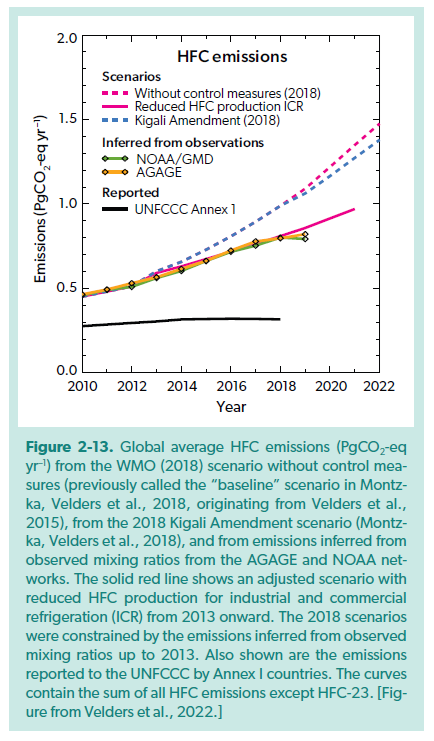Global and European HFC reported emissions compared to emissions derived from atmospheric monitoring
The Scientific Assessment 2022 Report (SAP2022, available here) provides revised forecasts for HFC emissions and compares reported global and regional emissions to these estimated from atmospheric monitoring. Projected emissions of HFCs based on current trends in consumption and emissions, national policies in several countries, and the Kigali Amendment, are lower than those projected in the 2018 Assessment. The new scenario also assumes that all countries adhere to the provisions of the Kigali Amendment. Compared to that scenario, the 2020–2050 cumulative emissions are reduced by 14–18 Pg CO2-eq [14,000 to 18,000 million tonnes CO2-eq] and the 2050 radiative forcing is reduced by 0.03 W m–2.
 Regional top-down emissions estimates [from atmospheric monitoring] for Europe, the USA, and Australia are similar to reported bottom-up emissions. Regional inverse modelling studies have not found evidence of underreporting of aggregate HFC emissions from Europe, the USA, or Australia. The emissions reported by Annex I countries in common reporting format (CRF) are approximately constant in the period 2015–2019, while atmospheric observations in the background atmosphere suggest continued growth in global total emissions. In 2019, reports by countries and regions to the UNFCCC accounted for only 31% (including HFC-23 in the analysis) or 37% (excluding HFC-23) of the global total CO2-eq emissions derived from observations. Inverse modelling studies have been carried out for China and India (both non-Annex I countries) and find that around one-third of the emissions gap (excluding HFC-23) could be explained by sources in these countries. The unattributed emissions probably occur in countries that are not monitored by atmospheric measurements and/or that do not report to the UNFCCC in CRF.
Regional top-down emissions estimates [from atmospheric monitoring] for Europe, the USA, and Australia are similar to reported bottom-up emissions. Regional inverse modelling studies have not found evidence of underreporting of aggregate HFC emissions from Europe, the USA, or Australia. The emissions reported by Annex I countries in common reporting format (CRF) are approximately constant in the period 2015–2019, while atmospheric observations in the background atmosphere suggest continued growth in global total emissions. In 2019, reports by countries and regions to the UNFCCC accounted for only 31% (including HFC-23 in the analysis) or 37% (excluding HFC-23) of the global total CO2-eq emissions derived from observations. Inverse modelling studies have been carried out for China and India (both non-Annex I countries) and find that around one-third of the emissions gap (excluding HFC-23) could be explained by sources in these countries. The unattributed emissions probably occur in countries that are not monitored by atmospheric measurements and/or that do not report to the UNFCCC in CRF.
For Europe, top-down (atmospheric monitoring) HFC-134a emission estimates are significantly lower than the reported HFC-134a emissions: Atmospheric measurement–based emissions estimates for the USA and Europe were discussed in the 2018 Assessment. Since then, additional studies have become available that support the conclusion that underreporting by UNFCCC Annex I countries does not explain the discrepancy with global top-down estimates. In Europe, new measurements of HFC-134a were carried out on the island of Crete, and these were combined with long-term measurements in Ireland, Switzerland, and Italy. These measurements allowed new estimates to be made of emissions from central and western Europe and the eastern Mediterranean. The top-down estimates of aggregated HFC-134a emissions for reporting countries in the domain were 51% (37–69%) lower than the reports to the UNFCCC (total top-down emissions were 18.6 (16.7–20.6) Gg yr–1 [18,600 tonnes] for this domain).
HFC-125 and HFC-143a emissions for Europe: Updated top-down emissions have been derived for several UNFCCC Annex I countries. These studies support the conclusions of the 2018 Assessment that the gap between reported and top-down emissions could not be explained by underreporting to the UNFCCC for countries that are monitored by atmospheric observations. Top-down estimated emissions of HFC-125 and HFC-143a in 2013 were smaller than, or consistent with, the reported emissions for central and western Europe and the eastern Mediterranean.
Global Emissions of HFC-32, -125, -143a: The year-to-year emissions  growth rate declined during this four-year period [2016-2020] for all three compounds. HFC-143a exhibited the most marked slowdown, with overall growth not significantly different from zero between 2016 and 2020.
growth rate declined during this four-year period [2016-2020] for all three compounds. HFC-143a exhibited the most marked slowdown, with overall growth not significantly different from zero between 2016 and 2020.
The SAP 2022 updated scenario for HFC emissions: The updated HFC scenario is constructed for the period 2019–2050, which takes into account updated trends in consumption and emissions, national regulations in place by 1 January 2021, and the provisions of the Kigali Amendment. The national regulations include the EU F-gas regulation and MAC directive, the HFC phasedown in the USA, and regulations in Japan. It also reflects lower reported consumption in China and is based on updated historical information on the use of HFCs in non-Article 5 countries, uses observed mixing ratios through 2020 as a constraint, and includes assumptions about reduced use of HFCs for industrial and commercial refrigeration (ICR). The trends in observed mixing ratios indicate a lower use of HFCs for ICR applications in recent years. The 2018 scenarios were constrained by the emissions inferred from observed mixing ratios up to 2013. The new scenario also assumes that all countries adhere to the provisions of the Kigali Amendment. Figure 2-13 reproduced from the SAP 2022 Assessment shows how HFC emissions in recent years are lower than the ‘baseline’ scenario from the 2018 Assessment.